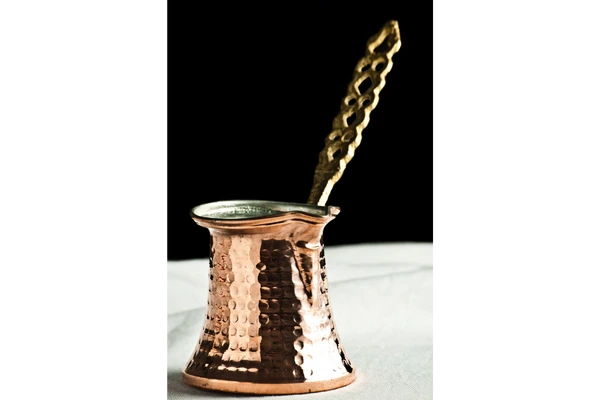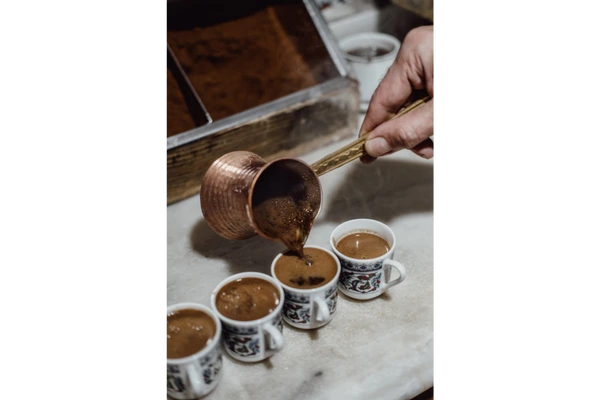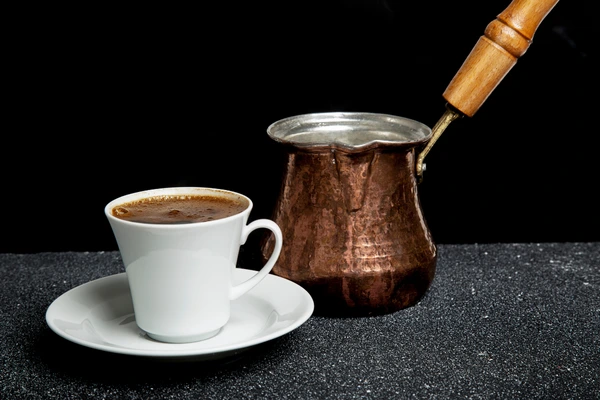If you’ve ever sipped coffee on the streets of Istanbul, or in places like the Balkans or the Levant, you know the vibe. Small cups. Rich, intense flavor. And that beautiful little pot with a long handle? That’s the cezve.
If you were lucky enough to snag a cezve on your travels (or smart enough to buy one when you got home), now’s the time to put it to work.
Here’s how to make Turkish coffee with a cezve, so every sip feels like it came straight from a tiny shop tucked into the alleys of Istanbul.
Disclaimer: This post may contain affiliate links. If you click and make a purchase, we may earn a small commission at no extra cost to you.
What Is a Cezve?
A cezve (pronounced jezz-veh) is a small, long-handled pot made specifically for brewing Turkish coffee.
Cezves are usually made of copper with a tin lining, but if you find brass, stainless steel, or even ceramic versions, don’t be surprised. These are still considered a cezve.
However, copper cezves are the best option. Copper gives you even and quick heating, which is crucial for extracting flavor from fine coffee grounds and creating the well-known Turkish coffee foam.
Which Cezve Size Is the Best?
A small cezve that can brew 1-2 cups of coffee is the best choice, especially if you’re just starting to brew Turkish coffee at home. It’s easier to get the right proportions and control boiling for foamy, strong coffee.
If you’ve got a larger one, you can still pull it off, but you may need a few tries to master the technique.

What Kind of Coffee Do You Need to Make Turkish Coffee?
Turkish coffee is best when you use 100% Arabica beans. It’s smoother, more complex, and gives Turkish coffee that balanced, slightly sweet edge.
If you go with Robusta coffee, you may end up with an overly aggressive and bitter cup of joe. So, keep Robusta beans for espresso blends.
Another thing to keep in mind is that medium-dark roast works best for Turkish coffee. Light roast will be too acidic, and dark roast will be too bitter. Medium-dark hits that sweet spot.
Here is our recommendation:
Grind Size Guide
To make a perfect cup of Turkish coffee, you need an extra fine grind, finer than espresso. It should resemble powdered sugar or flour.
Turkish coffee doesn’t get filtered, so the grind needs to be so fine it practically melts into the water as it brews. Most store-bought ground coffee won’t work. Even espresso grind is too coarse.
If you’re grinding at home, you’ll need a grinder that can handle Turkish-level fine. Blade grinders usually can’t do it, so try using a burr grinder or have it ground professionally.
The fine grind is crucial for a proper cup of Turkish coffee. It’s what gives the coffee its signature thickness, foam, and strong flavor without bitterness. Anything coarser, and you’ll lose all that magic.
How to Make Turkish Coffee with Cezve
Alright, time to put that cezve to work. Here is a step-by-step guide on how to make Turkish coffee with a cezve.
Step 1: Measure the Water
- Use your Turkish coffee cup (fincan) to measure the water. One cup of cold water per serving. Pour it into the cezve. It absolutely must be cold water.
Step 2: Add the Coffee
- Add one heaping teaspoon of Turkish-ground coffee per cup. Don’t be shy. If you want it stronger, go a little over.
Step 3: Add Sugar (Optional)
If you want sugar, add it now, before it goes on the heat. Once it’s cooking, no stirring is allowed.
Step 4: Stir It Only Once
Stir everything together. Make sure the grounds dissolve into the water, then stop. That’s it. From this point on, leave it alone.
Step 5: Heat Slowly
Place the cezve over low heat. Slow heating lets the flavors develop and helps build that signature foam.
As the coffee starts to heat, it’ll foam up. Right before it boils, the foam will rise to the top. The moment it starts to climb, pull it off the heat.
Step 6: Pour
Slowly pour the coffee, letting the grounds settle naturally. If you’re brewing more than one cup, divide the foam evenly with the spoon, then pour coffee.
Don’t have a cezve handy? You’re not out of luck. There are alternative ways to brew Turkish coffee using a simple saucepan. It’s not quite the classic method, but with a bit of care, you can still get a strong, flavorful cup.

Does Making Turkish Coffee with Cezve Make It Different?
The shape of the cezve (narrow neck and wider base) is designed to control heat and build pressure slowly. That’s what allows the foam to form properly.
Of course, you can still pull off a decent cup of Turkish coffee with other methods, but when you make it with a cezve, it’s not only easier, it also has soul. There’s a ritual to it. A rhythm. It just feels right.
Looking for a workaround? Here are the best tools you can use instead of a cezve.
Final Thoughts
Now that you have a guide on how to make Turkish coffee with a cezve, it’s up to you to start experimenting with different flavors and coffee grounds. And if you don’t have a cezve yet, let this be your sign to get one.


